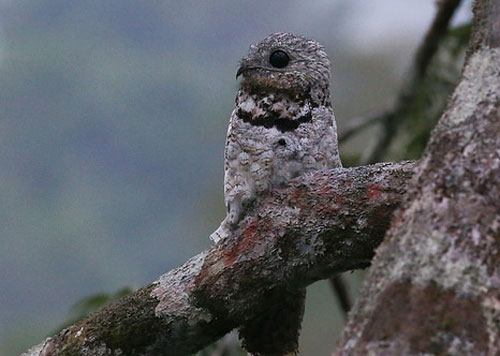
One of Sani’s three potoos, the Great, here sitting on a chick (single dark eye visible mid-belly) Photo: Jon Feenstra
The Amazonian lowlands of eastern Ecuador harbor one of the most diverse avian assemblages in the world, comparable to parts of eastern and southeastern Peru in both richness and beauty. Sani Lodge, three hours by boat down the Napo River from the end of the road at the Amazonian town of Coca, is situated on an oxbow lake in the heart of the Amazon rainforest and offers us excellent access to the region’s extraordinary diversity. Nearly 600 species of birds are known from this single locality, including five species of macaw, 10 puffbirds, seven toucans and more than 40 species of antbirds. From the lodge it is possible to see classic Amazonian species like White-throated Toucan, Red-bellied Macaw, Hoatzin, Masked Crimson Tanager, and Black-fronted Nunbird, all common, and with only a short canoe ride the rare and local become possible, including species like Zigzag Heron, Black-banded Owl, White-lored Antpitta, Orange-eyed Flycatcher, Orange-crowned Manakin, and the extremely local Cocha Antshrike. A sturdy steel 150-foot high canopy tower, easily accessible by stairs, supplies a brilliant dimension to Amazonian birdwatching: the ability to observe many rarely seen canopy species, such as King Vulture, Gray Antbird, Bare-necked Fruitcrow, Plum-throated Cotinga, White-browed Purpletuft, and a wide array of canopy tanagers and flycatchers.
This tour can be taken in conjunction with our tour Ecuador: The East Slope of the Andes.
Day 1: The tour begins this evening in Puembo, a colonial suburb of Quito. Night in Puembo.
The Amazon Lowlands tour was excellent. Jon was very knowledgable, kind, considerate and funny, and a great team player. I cannot imagine anything else I could hope for in a guide. The trip itself was a marvelous adventure, from the trip up the Napo River to arriving at the Sani Lodge to the excellent bird watching, to the great local guides, canoe trips, canopy tower and interaction with the Sani people. The food was very good and the Sani people couldn’t do enough for us. Thank you WINGS for your excellent organizational skills in putting together this amazing trip.
Harvey Kerstein, Feb 2020
Day 2: We’ll fly this morning over the Andes to the Amazonian oil town of Coca and board our motor boat for the three hour ride down the Napo River to Sani Lodge. As the lodge itself is located on an oxbow lake, not the main river, we’ll walk for about 15 minutes on a boardwalk trail to the lake then transfer to small dugout canoes for the tranquil 15-minute paddle to our accommodations for the next seven nights. After a welcome drink, we may make our first of many excursions out onto Challuacocha, the lake that is not only our “highway” to various parts of the nearby jungle, but also a prime birding spot of its own.
In fact, one of the most appealing aspects of our stay at Sani will be the leisurely canoe rides around this serene lake. We’ll be watched by the prehistoric-looking Hoatzins as we’re paddled around the edge in search of species found only in flooded forest and along the lake edges, including specialties such as White-chinned Jacamar, Dot-backed and Silvered Antbirds, Cinnamon Attila, Black-capped Donacobious, Buff-breasted Wren and the striking Masked Crimson Tanager. One of our main goals will be to snatch a glimpse of the local and elusive Zigzag Heron, a regular nocturnal denizen of thick vegetation along Amazonian lakeshores. The boardwalk between the Napo River and Challuacocha traverses excellent semi-flooded forest, and we’ll look for the shockingly yellow Cream-colored Woodpecker, as well as Plumbeous and White-shouldered Antbirds and Cocha Antshrike, a species that until 1990 was known to science only from a single female specimen. Night at Sani Lodge.
Days 3-8: Six full days at Sani will give us ample time to explore and re-explore the many different habitats accessible from the lodge. A highlight of any trip to Sani is a visit to two easily reached parrot clay licks. Literally hundreds of parrots come early in the morning to replenish their mineral supply by licking and pecking at exposed rocky areas. If we are fortunate, we may see as many as four or five species using the lick at the same time, including hundreds of Mealy and Blue-headed Parrots and the sublime Orange-cheeked Parrot. The trail system of Sani Lodge will enable us to explore superb primary varzea rainforest. The list of species found in this vanishing habitat is seemingly endless, and we’ll spend time walking through the forest in a quest for mixed-species flocks of woodcreepers, antbirds, ovenbirds, flycatchers and tanagers. Among the more beautiful birds that we’ll search for in this forest are Long-billed Woodcreeper, Many-banded and Lettered Aracaris, Golden-collared Toucanet, Chestnut-capped Puffbird, Waved, Ringed and Rufous-headed Woodpeckers, Fulvous Antshrike, Spot-backed Antbird, Wire-tailed, Striolated, Blue-crowned and Golden-headed Manakins, and Fulvous Shrike-Tanager. At night, we’ll look for Black-banded, Crested and Spectacled Owls and Tawny-bellied and Tropical Screech-Owls, as well as Great, Common and Long-tailed Potoos and Sand-colored Nighthawk.
One of our regular birding destinations during our stay will be canopy tower. With a sturdy metal staircase and a large metal platform that wraps around a gargantuan kapok tree, the tower will permit us access to one of the least-known habitats in the tropical rainforest, the canopy. Some of the many possibilities from the tower are Blue-throated Piping-Guan, Great Potoo, Blue-and-yellow Macaws, Spangled and Plum-throated Cotingas, White-browed Purpletuft, and Paradise, Green-and-gold, Turquoise, Opal-rumped, and Yellow-bellied Tanagers…perhaps even a Harpy or Crested Eagle. Each visit to the tower brings something unexpected.
Yasuni National Park on the south bank of the Rio Napo will be another of our destinations, and it is such rich birding that we will likely spend at least one full day exploring the trails that wind up into the upland terra firma forest. This drier hilly forest supports a different assortment of species and can also be productive for finding ant swarms. A swarm of army ants with birds feeding around them is one of the great rainforest birding spectacles, and some of the specialties here include Ochre-striped Antpitta, Lunulated, Hairy-crested, White-plumed and Banded Antbirds, Ringed Antpipit, and Blue-backed Manakin.
A morning or afternoon will be devoted to visiting islands in the Napo River, where a yet another different set of species can be found, some of which are so specialized in their unique habitats that they have never been recorded on the mainland. We’ll look particularly for White-bellied Spinetail, Castelnau’s Antshrike, Black-and-white Antbird, Lesser Wagtail-Tyrant, River Tyrannulet, Mottle-backed Elaenia and Orange-headed Tanager. Along the river itself we will hopefully see Collared Plover, Pied Lapwing, Large-billed and Yellow-billed Terns and possibly roosting Ladder-tailed Nightjars that frequent the sandbars. Nights at Sani Lodge.
Day 9: We may have a little time to bird around in the morning before we depart the lodge for our boat ride back to Coca and our flight back to Quito, arriving at our hotel before dinner. Night in Puembo.
Day 10: The tour concludes this morning in Puembo.
Updated: 14 March 2024
Prices
- 2025 Tour Price : $5,190
- Single Occupancy Supplement : $1,100
Notes

Questions? Tour Manager: Greg Greene. Call 1-866-547-9868 (US or Canada) or (01) 520-320-9868 or click here to email.
* Tour invoices paid by check carry a 4% discount. Details here.
Maximum group size seven with one leader.
